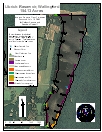Ulbrich Reservoir, Wallingford
No other species was nearly as abundant or frequently found. Coontail (Ceratophyllum demersum) occurred in scattered locations around the lake, primarily at the southern end, where it grew abundantly with Eurasian watermilfoil. Water smartweed (Polygonum amphibium) occurred in several locations on the eastern shore and in shallow water at the extreme northwest of the lake. Several other species were recorded in the same area, including duckweed (Lemna minor) and snailseed pondweed (Potamogeton bicupulatus.
Small pondweed (Potamogeton pusillus) and slender naiad (Najas flexilis) were observed in several patches near the shore at the southern end of the reservoir. Both species also occurred among Eurasian watermilfoil along the western shore in the southern half of the reservoir, as did coontail and marsh primrose-willow (Ludwigia palustris).
| Species recorded in our 2005 survey of Ulbrich Reservoir. Scientific Names *Invasive Species |
|
| Common duckweed | Slender naiad |
| Coontail | Small pondweed |
| Eurasian watermilfoil* | Snailseed pondweed |
| Marsh primrose-willow | Water smartweed |


